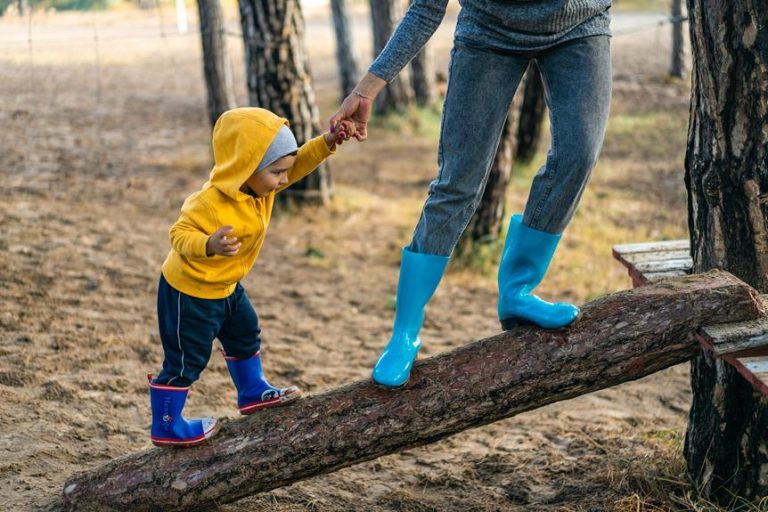Balance Bikes vs Training Wheels: Which is Better?
Learning to ride a bike is a milestone in many people’s lives. However, there are more and more parents who wonder whether the traditional training wheels are the right way to go.
If you do not think that training wheels are the best option you should consider the balance bike. You need to look at why parents feel training wheels are not a good option, what a balanced bike is, and how it can help your child learn to ride a bike.
Dive into this thrilling comparison to unravel the pros and cons of each method, and unveil the secrets to finding the perfect balance for your little rider’s safety and success.
Balance Bikes vs Training Wheels
When comparing balance bikes to training wheels for teaching children how to ride a bicycle, both methods are effective and safe.
Balance bikes, with their lower-to-the-ground and lightweight design, offer benefits such as improved maneuverability and the promotion of natural balance development.
On the other hand, training wheels provide versatility and adaptability, being suitable for various bikes and terrains.
Ultimately, both approaches aim to help children transition to riding a regular bike independently, with the key being to maintain a positive learning environment and offer support throughout the process.
Key Points:
- Balance bikes promote natural balance development with their low-to-the-ground design and lightweight build
- Training wheels offer versatility and adaptability for various bikes and terrains
- Both methods are effective and safe for teaching children how to ride a bicycle
- The goal of both approaches is to help children transition to riding a regular bike independently
- Maintaining a positive learning environment and providing support is key throughout the learning process
- Balance bikes provide improved maneuverability, while training wheels offer adaptability
Check this out:
💡 Did You Know?
1. Strider Bikes, a popular brand of balance bikes, were originally developed as a tool to help children with special needs improve their coordination and balance.
2. The concept of balance bikes originated in Europe in the early 19th century and were used as a way for children to learn how to balance on two wheels before transitioning to a pedal bike.
3. Training wheels were first patented in 1899 by Arthur Swanson, who aimed to provide a safer alternative for children learning to ride bicycles.
4. Balance bikes have been found to be more effective than training wheels in teaching children how to ride a bike without the need for extra support, as they encourage a natural sense of balance and coordination.
5. In recent years, balance bikes have gained popularity among adults as a fun and effective way to improve balance, coordination, and core strength.
Introduction To Balance Bikes Vs Training Wheels
When teaching children how to ride a bicycle, the debate between balance bikes and training wheels is longstanding. Balance bikes, also known as strider bikes, are gaining popularity for their innovative design that eliminates the need for training wheels. Meanwhile, traditional pedal bikes with training wheels have remained a staple for generations. In this article, we will explore the key characteristics, features, benefits, and drawbacks of balance bikes and training wheels to help parents make an informed decision on the best method for their child.
Characteristics Of Balance Bikes
- Balance bikes are a type of bicycle designed without pedals, drivetrain, or brakes.
- Children use their feet to propel themselves forward and to stop the bike.
- These bikes typically have handlebars, a seat, and two wheels, but lack additional components found in traditional pedal bikes.
- The lightweight and low-to-the-ground design of balance bikes makes them ideal for younger children and toddlers starting to learn how to ride.
- Balance bikes promote a more natural and intuitive way of learning by encouraging children to use their feet to balance and glide.
Features Of Pedal Bikes
- Pedal bikes have pedals attached to a drivetrain, making them heavier and higher off the ground compared to balance bikes.
- These bikes require hand brakes or coaster brakes for stopping, adding an additional layer of complexity to the learning process.
- While pedal bikes may be more challenging for beginners, they offer the versatility of being able to ride longer distances once the child has mastered the basics.
- The transition from training wheels to riding a pedal bike can be a significant milestone for children as it signifies their growth in confidence and skill.
Benefits Of Choosing A Balance Bike
- Key benefits of choosing a balance bike for your child include the lightweight and accessible design that makes it easier for younger children to learn how to ride.
- Balance bikes typically weigh between 6-9 pounds, making them easier for children to maneuver and control.
- The low-to-the-ground feature of balance bikes adds an extra layer of safety for young riders who may be prone to falls.
- Additionally, balance bikes help children develop their balance and coordination at an early age, setting a solid foundation for future biking skills.
Drawbacks Of Balance Bikes
- Balance bikes offer numerous benefits for children learning to ride bikes.
- One main limitation is that balance bikes cannot be converted into pedal bikes.
- As a result, children may need to transition directly from a balance bike to a pedal bike, which can be challenging for some.
- Balance bikes may not be suitable for hilly terrain or longer rides, as they lack the necessary components for sustained pedaling.
Why Training Wheels Are Bad?
Training wheels have long been the staple for getting children comfortable with riding a bike. They offer a stable platform that lets the children get used to the motions of the bike and how to use it. However, many problems come with using training wheels.
The primary problem with training wheels is that they do not teach the child how to balance on the bike. This is one of the most important aspects of riding a bike. If you cannot balance correctly you are not going to be able to ride the bike properly and this could lead to injury.
The second problem that you need to consider is when you have to make the transition from training wheels to no training wheels. The movement from four wheels to two can be very scary for children particularly if they do not have the correct level of balance needed. This is one of the reasons why many children do not want to move away from the training wheels. For more info, here’s a helpful community site on promoting freedom from training wheels.
Advantages Of Training Wheels
- Training wheels provide a traditional method to teach children how to ride a bike.
- The versatility of training wheels allows them to be attached to nearly any bike, offering stability for new riders.
- Brakes are also available with training wheels, which are crucial for maneuvering hills and uneven surfaces.
- Parents can assist their child in transitioning to riding a standard bike by adjusting the training wheels gradually as the child gains confidence.
Transitioning To Regular Bikes
Regardless of whether a child starts with a balance bike or training wheels, the ultimate goal is for them to ride a regular bike without any additional support. This transition can be a significant milestone for children as it signifies their growth and progress in mastering the skill of riding a bike. By providing the right support, encouragement, and opportunities for practice, parents can help their child make a smooth transition to riding a regular bike.
- The transition from a balance bike or training wheels to a regular bike is a major milestone
- Support, encouragement, and regular practice are key for a smooth transition
“Transitioning to riding a regular bike is an important step in a child’s development and can be achieved with proper guidance and practice.“
Tips For Teaching Bike Riding
Teaching a child how to ride a bike can be a rewarding but challenging experience for both parents and children. Here are some tips to make the process smoother and more enjoyable:
- Start early and be patient: Introduce your child to the concept of riding a bike at an early age and be patient with their progress.
- Use protective gear: Always ensure that your child wears a helmet and other protective gear to prevent injuries.
- Practice in a safe environment: Choose a flat, open space with minimal traffic to practice riding skills.
- Provide encouragement: Celebrate small victories and provide positive reinforcement to boost your child’s confidence.
- Make it fun: Turn bike riding into a fun and enjoyable activity by incorporating games and challenges.
In conclusion, whether you choose a balance bike or training wheels for your child, the most important thing is to make the learning process fun, safe, and supportive. Each method has its own unique benefits and drawbacks, so it’s essential to consider your child’s individual needs and preferences when making a decision. By providing the right guidance and support, you can help your child develop the skills and confidence needed to ride a bike independently.
FAQ
What is better balance bike or training wheels?
Although both balance bikes and training wheels serve as tools to help children learn how to ride a bike, the balance bike has proven to be more effective in promoting early independence and confidence in riding. By initially focusing on mastering balance and coordination, children using balance bikes develop a strong foundation that allows them to progress to pedaling sooner. This approach not only enhances their overall riding skills but also instills a sense of control and agility from the beginning.
On the other hand, training wheels provide stability and support, but they may hinder the development of essential balancing skills. While they offer a sense of security, they can also create a dependency that delays the transition to independent pedaling. Ultimately, the balance bike method appears to offer a more well-rounded approach to learning to ride a bike, emphasizing fundamental skills that pave the way for a smoother and more rapid progression towards cycling proficiency.
What are the disadvantages of a balance bike?
While balance bikes are beneficial for developing balance and coordination skills, one notable drawback is the limited lifespan of these bikes. Since most balance bikes cannot be converted into pedal bikes, parents may need to invest in a new bicycle once their child is ready to transition to pedaling. This can result in additional costs and the need for storage space for multiple bikes.
Another disadvantage of balance bikes is that they may not be suitable for all terrains or surfaces due to their design. While they excel on flat and smooth surfaces, they may struggle on rougher terrains or hills, limiting the options for outdoor exploration and adventure. This could potentially restrict the child’s overall biking experience and exposure to different environments.
What age is appropriate for a balance bike?
The perfect age for a child to begin riding a balance bike is around 18 months to 2 years old. At this stage, most children have developed the necessary physical and cognitive skills to handle balancing on a bike. It’s an exciting time for toddlers to start exploring their coordination and sense of independence through an early introduction to biking. By starting early, children can quickly build confidence and enhance their motor skills while having fun on two wheels!
Should a 2-year-old ride a balanced bike or a normal bike?
A 2-year-old child would benefit from starting with a balance bike to develop their balancing and steering abilities. Once they have mastered these skills, they can transition to a regular bike to learn to pedal. This progression allows for a smooth development of their biking skills and sets a strong foundation for future cycling adventures. It’s important to match the bike to the child’s current abilities and provide a safe and enjoyable biking experience.





